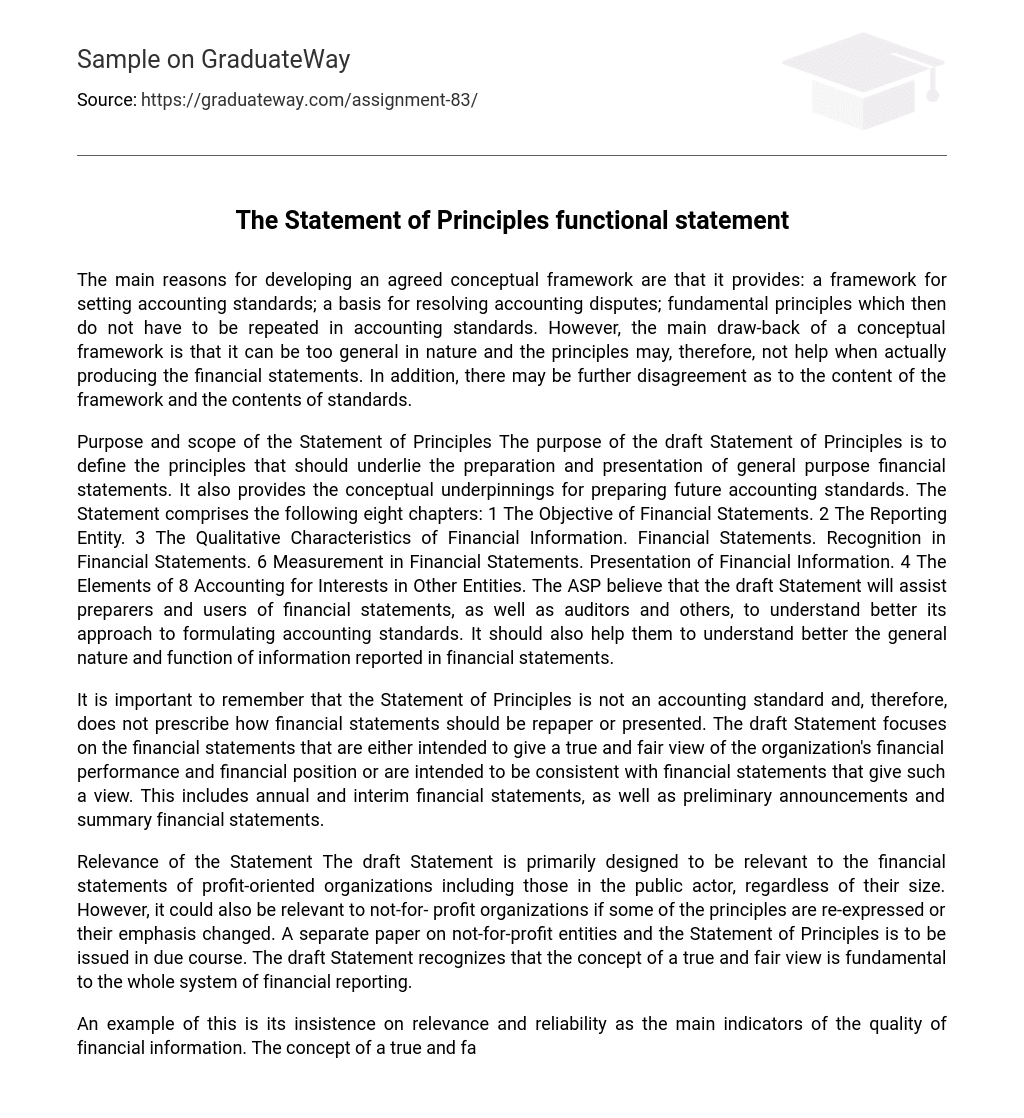The primary purpose of developing a consensus conceptual framework is to serve as: a structure for establishing accounting standards, a foundation for resolving accounting conflicts, and basic principles that do not need to be reiterated in accounting standards. Nonetheless, a major limitation of a conceptual framework is its potential to be overly broad and having principles that may not necessarily assist in actually producing financial statements. Furthermore, debates may arise regarding the framework’s content and the content of standards.
The purpose of the draft Statement of Principles is to define the principles that should underlie the preparation and presentation of general purpose financial statements. It also provides the conceptual underpinnings for preparing future accounting standards. The Statement comprises the following eight chapters: 1 The Objective of Financial Statements. 2 The Reporting Entity. 3 The Qualitative Characteristics of Financial Information. Financial Statements. Recognition in Financial Statements. 6 Measurement in Financial Statements. Presentation of Financial Information. 4 The Elements of 8 Accounting for Interests in Other Entities. The ASP believe that the draft Statement will assist preparers and users of financial statements, as well as auditors and others, to understand better its approach to formulating accounting standards. It should also help them to understand better the general nature and function of information reported in financial statements.
The Statement of Principles does not serve as an accounting standard but rather focuses on accurately representing a company’s financial performance and position. It should not be confused with guidelines for preparing or presenting financial statements. The types of statements it covers include annual and interim financial reports, preliminary announcements, and summary financial statements.
The draft Statement is designed to be relevant to the financial statements of profit-oriented organizations, including those in the public sector, regardless of size. It may also be relevant to not-for-profit organizations if some principles are re-expressed or their emphasis changed. A separate paper on not-for-profit entities and the Statement of Principles will be issued later. The draft Statement acknowledges the importance of the concept of a true and fair view in the overall system of financial reporting.
An example of this is its insistence on relevance and reliability as the main indicators of the quality of financial information. The concept of a true and fair view is considered to be the ‘ultimate’ and lies at the core of all financial reporting. It is regarded as the ultimate test for financial statements and, as such, has a direct effect on accounting practice. Financial statements will not give a true and fair view unless the information they contain is sufficient in quantity and quality to satisfy the reasonable expectations of the readers to whom they are addressed.
The ASP aims to respond to changing expectations over time by setting accounting standards and issuing other pronouncements. The goal of financial statements, according to the Statement of Principles, is to provide information about a reporting entity’s financial performance and position that is useful to a wide range of users. This includes assessing management’s stewardship and making economic decisions. All subsequent principles within the Statement are developed based on this objective. Essentially, the Statement assumes that focusing on the information needs of present and potential investors can help achieve this objective. Investors require information about the organization’s financial performance and position in order to evaluate its cash generation ability and financial adaptability.
The main principle in preparing financial statements is to provide relevant, reliable, comparable, and understandable information. The goal should be to ensure that the financial statements offer valuable information by determining what to include and how to present it. The materiality test is used to evaluate if the usefulness of the information justifies its inclusion in the financial statements.
According to ASAP 2, information is deemed material to the financial statements if its misstatement or omission could potentially impact the economic decisions made by the users of those financial statements. The fundamental accounting concepts, as defined in ASAP 2, are commonly referenced in later Soaps and have been recognized by academic writers and others as an integral part of the accounting conceptual framework.
According to the standard, the four concepts are defined as follows: Going concern means that the enterprise will continue operating in the foreseeable future without any intention or necessity to liquidate or significantly reduce its scale of operation. Accruals refer to revenues and costs being recognized when they are earned or incurred, rather than when the money is received or paid, and matched with each other based on their established or assumed relationship.
The text emphasizes the importance of consistency in accounting treatment within a specific accounting period and from one period to the next. It also highlights the concept of prudence, which states that revenue and profits should only be recognized in the profit and loss account when they are realized either in the form of cash or other assets that can be reasonably assessed for eventual cash realization. Additionally, provisions should be made for all known liabilities, whether their amounts are certain or estimated based on available information.
ASAP 2 recognizes that the significance of these ideas may differ depending on the specific case. Nonetheless, it emphasizes that when the concept of accruing is contradictory to the concept of prudence, prudence should be given priority. At level C, candidates must be capable of defining these concepts and implementing them when creating financial statements.





